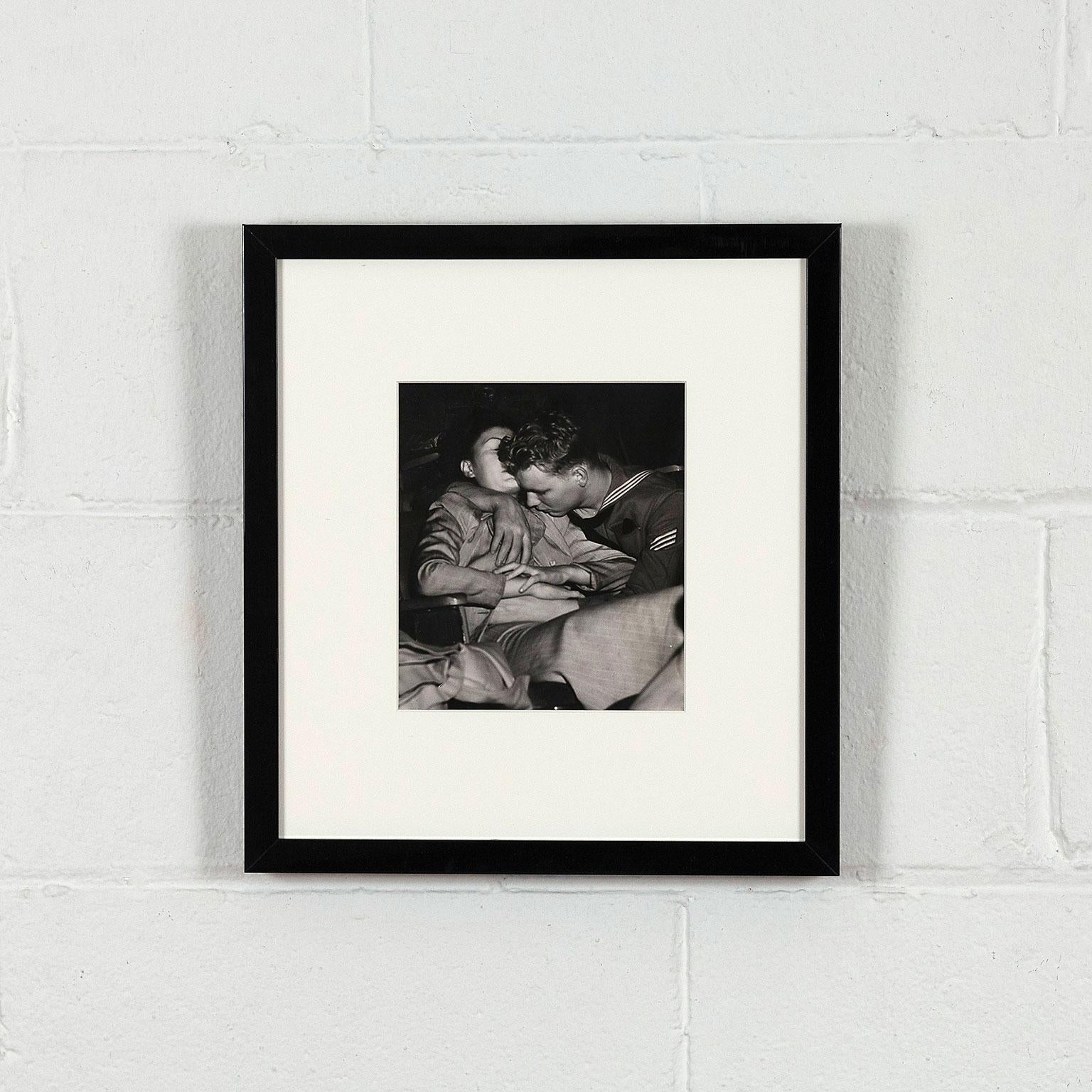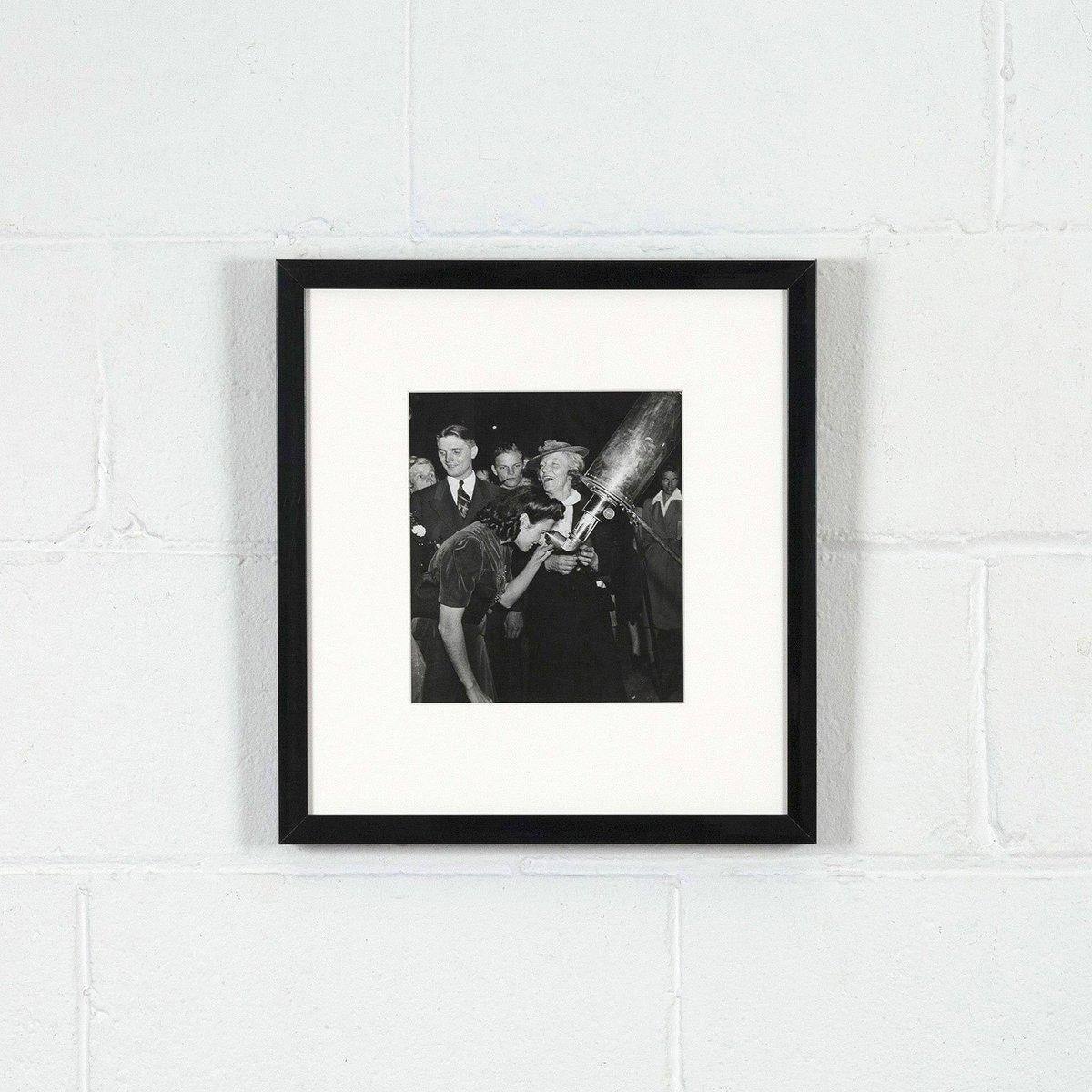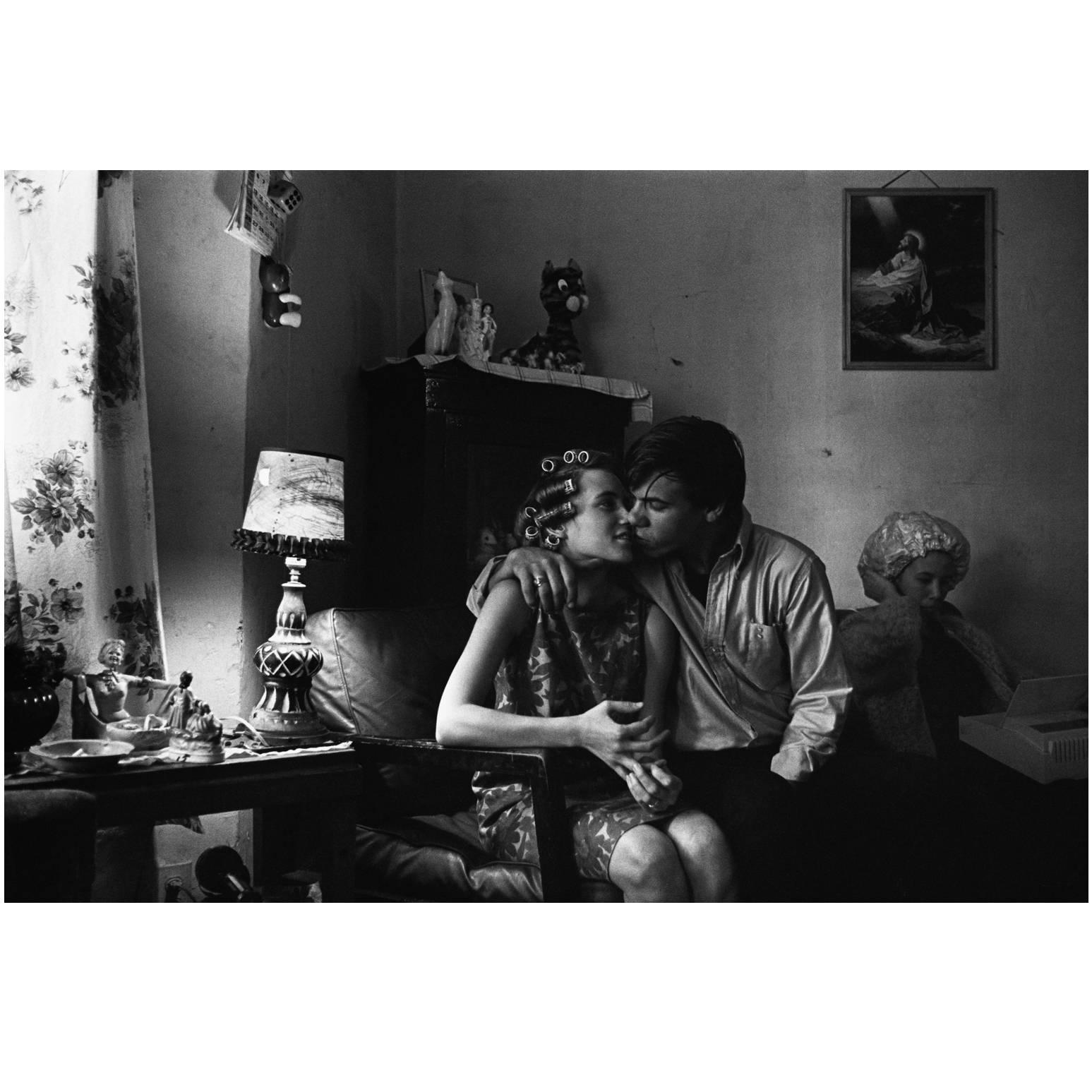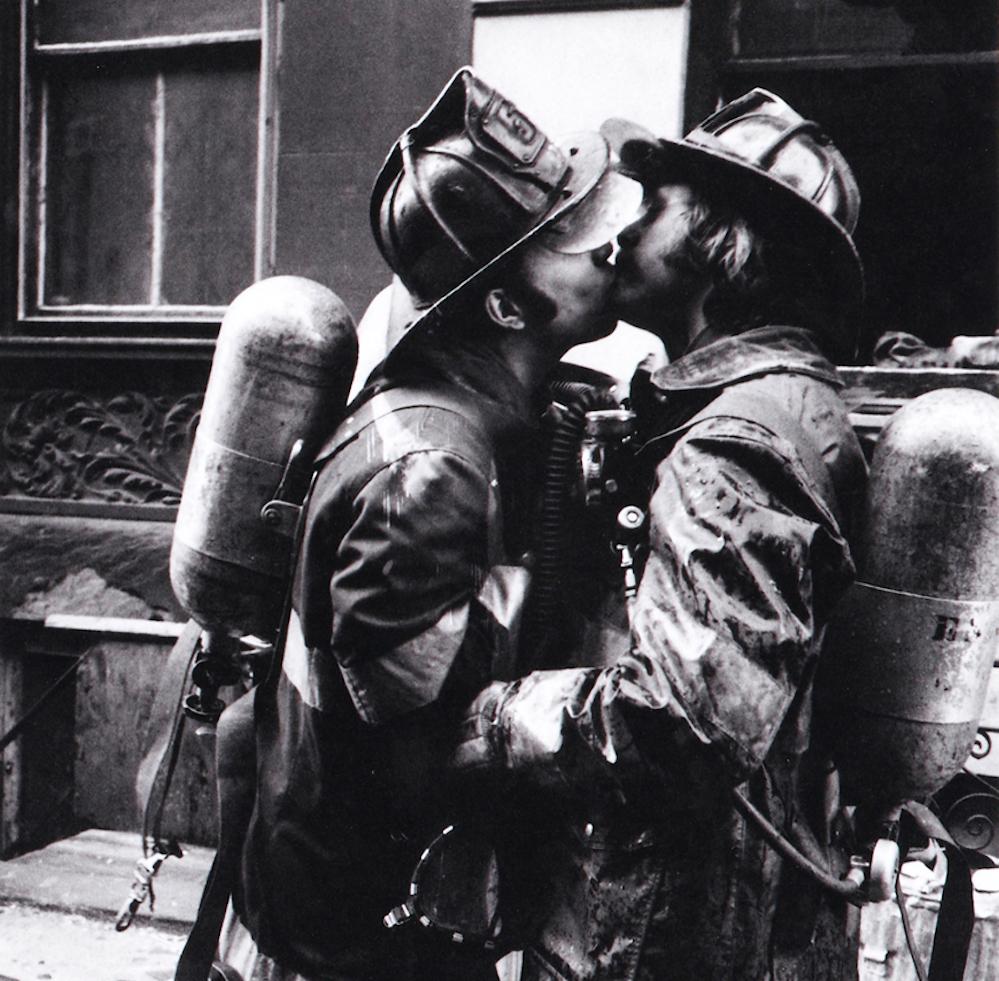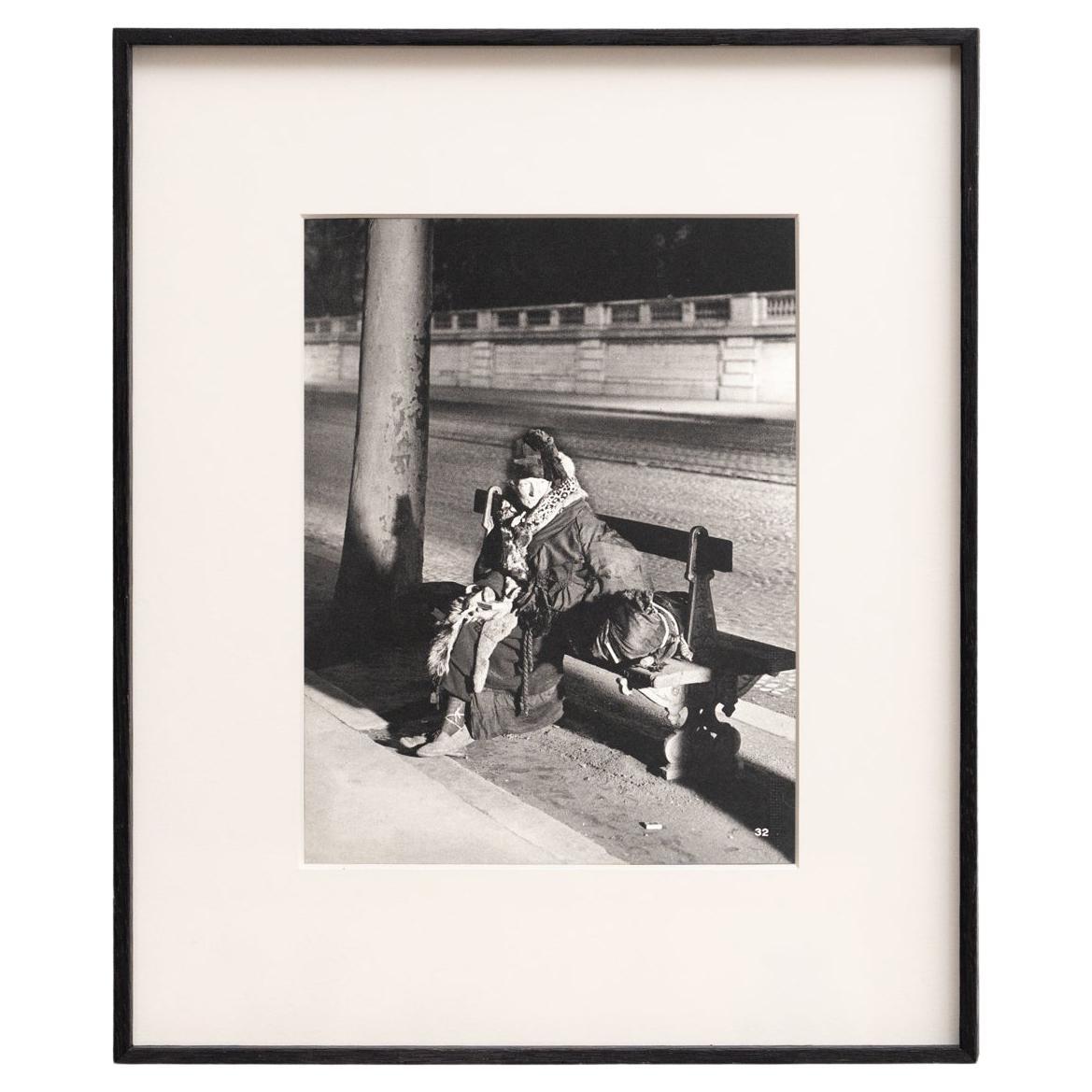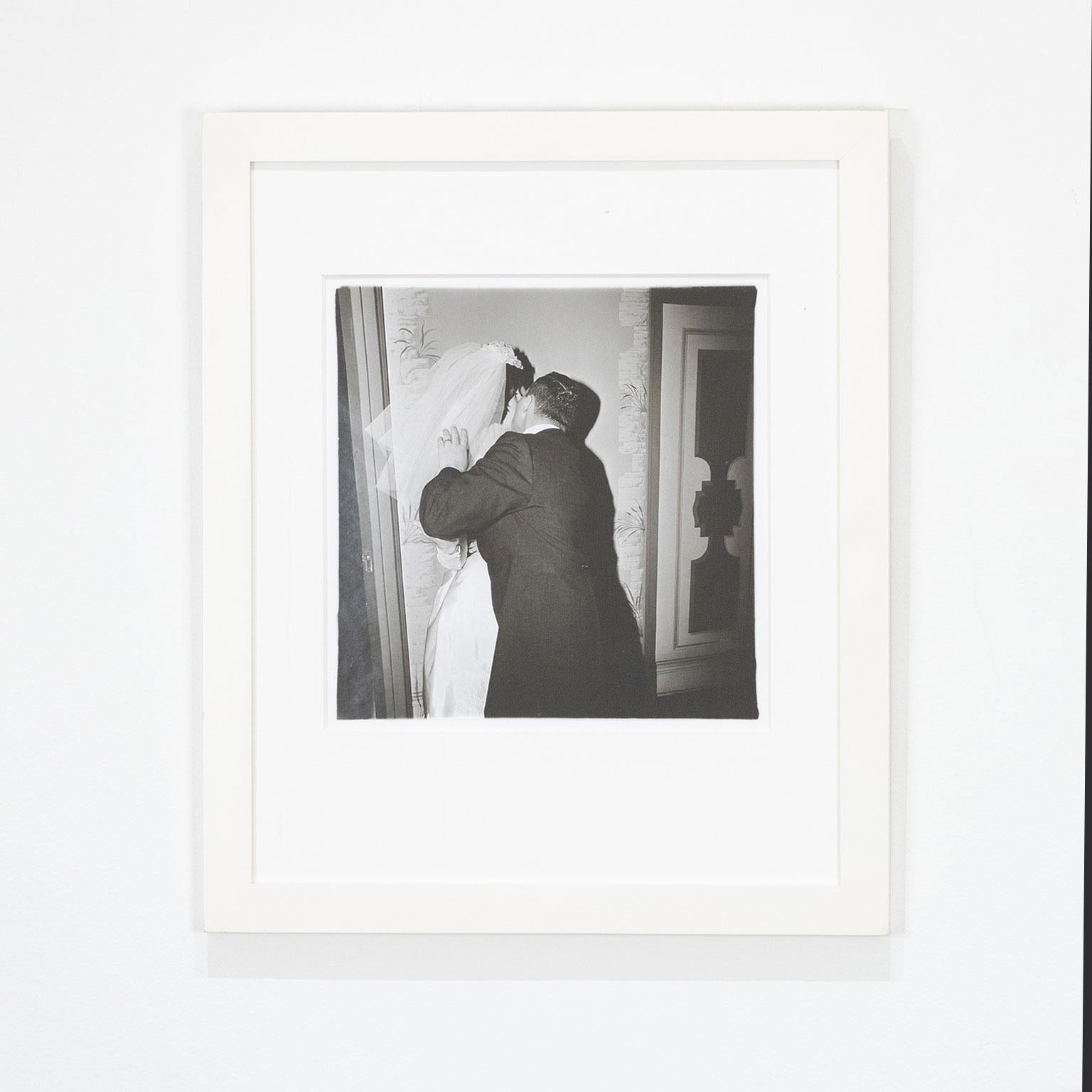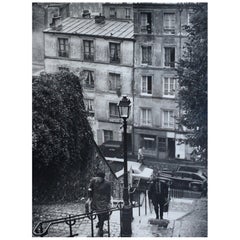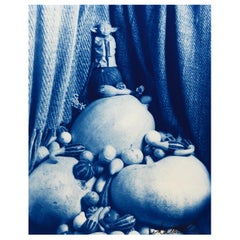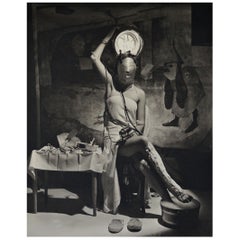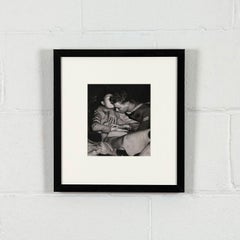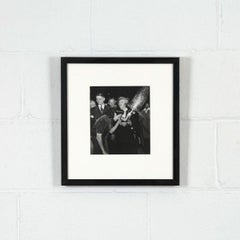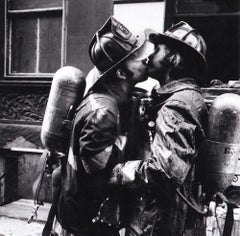Items Similar to Weegee 'Cafe Romance', New York, 1953
Want more images or videos?
Request additional images or videos from the seller
1 of 5
Weegee 'Cafe Romance', New York, 1953
$6,500
£4,969.60
€5,723.97
CA$9,108.49
A$10,168.78
CHF 5,328.29
MX$124,475.80
NOK 67,669.28
SEK 63,803.54
DKK 42,718.58
About the Item
Weegee (Ukranian/American 1899-1968)
Title: 'Cafe Romance', New York 1953
Gelatin silver print
Signed, titled, dated in ink au verso
'Corkin Gallery' label au verso
stamped "weegee the famous" au verso
Image size: 11" x 13.5"
Mat size: 21" x 24"
Biography:
Probably few policemen have seen as much violent sin as Arthur Fellig, better known as Weegee, did. Specializing in crime and catastrophe, Weegee’s work is regarded as some of the most powerful images of the 20th century. His profound influence on other photographers derives not only from his sensational subject matter and his use of the blinding, close-up flash, but also from his eagerness to photograph the city at all hours, at all levels: coffee shops at three in the morning, hot summer evenings in the tenements, debutante balls, parties in the street, lovers on park benches, the destitute and the lonely. No other photographer has better revealed the non-stop spectacle of life in New York City.
During the 1930s and 1940s Weegee worked as a freelance news photographer in New York City, and was the first private citizen to gain access to police radio transmits. He lived across the street from Manhattan police headquarters waiting for the inevitable call that would announce another gangland execution, botched hold-up, or crime of passion.
Weegee’s first book, Naked City, was a runaway success, making him an instant celebrity who suddenly had assignments from Life and Vogue. He was among the first to fully realize the camera’s unique power to capture split-second drama and exaggerated emotion. By the mid-40s, Weegee photographed the furred and bejeweled grandes damesat the Metropolitan Opera and celebrities such as Marilyn Monroe, Andy Warhol, John F. Kennedy, and Liberace, as well as his beloved street people.
No other photographer has ever portrayed a city with Weegee's level of intimacy, amorality, complicitness and humor. While his intent was simply to photograph "the soul of the city I knew and loved," his unflinching eye set the trend for young, edgy photographers in the 1960s. He strips the citizens bare, all of them, poor, rich and middling. There is no looking down or looking up: he is too mixed up in everything he sees, too much part of the shenanigans, exposing the bare truth of a city filled with hungers, lusts, and passions.
Collections:
The Indianapolis Museum of Art
J. Paul Getty Museum, Los Angeles
Museum of Modern Art, New York City
San Francisco Museum of Modern Art
Museum of Modern Art, Oxford, United Kingdom
Museum of Contemporary Art, Los Angeles
International Center of Photography, New York City
Selected Solo Exhibitions:
2012
Weegee: Murder Is My Business- International Center of Photography, New York City
Weegee: Naked City – Steven Kasher Gallery, New York City
2011
Naked Hollywood: Weegee in Los Angeles – The Museum of Contemporary Art, Los Angeles
2006
Unknown Weegee – International Center of Photography, New York City
2003
Weegee’s Trick Photography – International Center of Photography, New York City
1997
Weegee’s World: Life, Death and the Human Drama – International Center of Photography, New York City
1977
Weegee the Famous – International Center of Photography, New York City
1962
Weegee by Weegee – Photokina, Cologne, Germany
1960
Weegee: Charicatures of the Great – Photokina, Cologne, Germany
1941
Weegee: Murder is my Business – The Photo League, New York City
Selected Group Exhibitions:
2004
Out of Place – Galerie Nordenhake, Berlin
1948
50 Photographs by 50 Photographers – The Museum of Modern Art, New York City
1943
Action Photography – The Museum of Modern Art, New York City
Selected Publications:
Naked Hollywood: Weegee in Los Angeles published by Skira Rizzoli (2011)
Weegee: Murder Is My Business published by ICP (2011)
Unknown Weegee published by ICP/Steidl (2006)
Weegee: Photographs from the J. Paul Getty Museum published by Getty Publications (2005)
Weegee published by Phaidon (2004)
Weegee’s World published by Bulfinch (2000)
Weegee’s New York Photography 1935-1960 published by Te Neues (2000)
The Village published by Da Capo Press (1989)
Weegee the Famous published by Capa, Cornell, and Coplans (1977)
Weegee’s Creative Photography published by Ward Lock (1964)
Weegee by Weegee: An Autobiography published by Da Capo Press (1961)
Weegee’s Creative Camera published by Hanover House (1959)
Weegee’s Secrets of Shooting with Photoflash published by Designers 3 (1953)
Naked Hollywood published by Pellegrini and Cudahy (1953)
Weegee’s People published by Duell, Sloan & Pearce (1946)
Naked City published by Duell, Sloan & Pearce (1945).
- Creator:Weegee 1 (Photographer)
- Dimensions:Height: 21 in (53.34 cm)Width: 24 in (60.96 cm)Depth: 0.25 in (6.35 mm)
- Place of Origin:
- Period:
- Date of Manufacture:1953
- Condition:
- Seller Location:Hamilton, CA
- Reference Number:1stDibs: LU1355213893901
About the Seller
5.0
Platinum Seller
Premium sellers with a 4.7+ rating and 24-hour response times
Established in 2010
1stDibs seller since 2015
1,330 sales on 1stDibs
Typical response time: 3 hours
- ShippingRetrieving quote...Shipping from: Hamilton, Canada
- Return Policy
Authenticity Guarantee
In the unlikely event there’s an issue with an item’s authenticity, contact us within 1 year for a full refund. DetailsMoney-Back Guarantee
If your item is not as described, is damaged in transit, or does not arrive, contact us within 7 days for a full refund. Details24-Hour Cancellation
You have a 24-hour grace period in which to reconsider your purchase, with no questions asked.Vetted Professional Sellers
Our world-class sellers must adhere to strict standards for service and quality, maintaining the integrity of our listings.Price-Match Guarantee
If you find that a seller listed the same item for a lower price elsewhere, we’ll match it.Trusted Global Delivery
Our best-in-class carrier network provides specialized shipping options worldwide, including custom delivery.More From This Seller
View AllAndre Kertesz 'Montmarte', Paris, 1963
By Andre Kertesz
Located in Hamilton, Ontario
Andre Kertesz (Hungarian/American 1894-1985)
Title: 'Montmarte', Paris, 1963
Gelatin silver print
Signed in ink
titled, dated '10-31-63' in artists hand in ink au verso
'Cork...
Category
20th Century Unknown Photography
Linda McCartney, 'Autumn', 1987
By Linda McCartney
Located in Hamilton, Ontario
Linda McCartney (American 1941-1998)
"Autumn" 1987
From the Sun Prints series
9.5 x 8 blue cyanotype
signed on the image
sheet size 14.5 x 16
matt size 15 x 18.75
used for book Sun Prints page 64
Jane Corkin gallery label on verso.
Biography:
Linda Louise McCartney (née Eastman) was born in Scarsdale, New York, on 24th September 1941. She graduated from Scarsdale High School, Westchester County, New York in 1960, and went on to study at the University of Arizona, where she majored in art history.
Although her formal training extended to just two lessons on photography that she attended at a night school whilst studying as an art history major at the University of Arizona, the pictures by Walker Evans, Dorothea Lange and Edward Weston that she discovered there – along with her later introduction to the photography of Edward Steichen – inspired and influenced Linda’s work. Linda was also fascinated by the history of photography and honoured the early photographic pioneer William Henry Fox by producing handcrafted cyanotype prints. Linda experimented with other printing processes throughout her career as well as producing thousands of Polaroids.
Linda got her first big break as a photographer while working as an editorial receptionist at Town and Country Magazine. She used an unwanted invitation to a Rolling Stones promotional party on the SS Sea Panther on the Hudson River to document the event and photograph the band. The magazine was so impressed with Linda’s candid, intimate and relaxed photographs of the Rolling Stones that they published her images in an editorial feature – her first of many magazine commissions.
Linda became a professional photographer in the mid-sixties. Her pictures during this period chronicled the musical revolution of the decade.
Whilst working as the house photographer at the Fillmore East in New York City she photographed many iconic musicians including; The Rolling Stones, Otis Redding, B.B. King, The Doors, The Grateful Dead, Frank Zappa, The Beach Boys, The Who, Cream, The Kinks, Traffic, The Byrds and Jimi Hendrix.
Linda’s photograph of Eric Clapton for Rolling Stone magazine’s 11th May 1968 issue made her the first female photographer to have work featured on the magazine’s cover
In 1967, after being named US female photographer of the year, Linda was in London to shoot an assignment on the ‘Swinging Sixties’. Linda met Paul McCartney at the Bag O’Nails Club and then again four days later at the launch of Sgt. Pepper’s Lonely Hearts Club Band at Brian Epstein’s house in Belgravia. A year later they married at Marylebone Registry Office, London, March 12th, 1969.
After receiving credits on Paul’s solo album RAM, Linda joined Paul on stage, as keyboard player and vocalist, in Wings. Throughout her time in Wings Linda documented her travels and family life on and off stage. She went on to write and record several songs of her own, including ‘Seaside Woman’, released in 1977 through Epic Records in the US, under the band name Suzy and The Red Stripes. Linda’s album Wide Prairie was release posthumously in 1998.
In 1989, Linda began to pioneer another passion, to save the lives of animals through promoting the vegetarian lifestyle that she and Paul and long embraced. Her first two vegetarian cookbooks...
Category
20th Century American Photography
Ralph Gibson 'Artifacts'
By Ralph Gibson
Located in Hamilton, Ontario
Ralph Gibson (American born 1939)
Title: 'Artifacts'
Full portfolio containing 10 photographs on fibre based silver gelatin photographic paper and clamshell box
Each piece signed ...
Category
20th Century American Photography
$12,500
Horst P. Horst 'Electric Beauty', 'Blanche Grady, ' Paris, 1939
By Horst P. Horst
Located in Hamilton, Ontario
Horst P. Horst (German/American 1906-1999)
Title 'Electric Beauty', (Blanche Grady), Paris, 1939.
Signed in Pencil.
Edition 5 of 10.
Platinum Print
Refere...
Category
20th Century Photography
Andre Kertesz 'Melancholic Tulip', 1929
By Andre Kertesz
Located in Hamilton, Ontario
Andre Kertesz (Hungarian/American 1894-1985)
Title: 'Melancholic Tulip', 1929
Gelatin silver print
Signed in ink
titled, dated 'Feb 10 1929' in ink
'Corkin Gallery' and 'Niko...
Category
20th Century Hungarian Photography
Art Deco Photographs from The Strand Theatre in Times Square, Broadway, New York
Located in Hamilton, Ontario
Five original photographs from live Broadway performances at the historic Strand Theater. The Strand Theatre was originally an early movie palace locate...
Category
Vintage 1920s American Art Deco Photography
Materials
Paper
You May Also Like
Weegee "Sailor and Girl Kissing"
By Weegee
Located in Toronto, Ontario
Weegee (1899-1968) was equally fascinated and inspired by cinema and all of its tangents, from Hollywood movie stars to ordinary civilians going to the movies. While Weegee is typically associated with crime/disaster images, the broad theme of "entertainment" is a major component of his oeuvre.
An interesting and provocative sub-genre of his cinema-related work are his images of couples (often heavy-petting) in movie theatres.
Recent scholarship has established that many of Weegee's supposed clandestine images were actually staged or arranged with friends or co-operative strangers.
Nevertheless, Weegee created these photographs in the dark with an array of clever techniques including infrared film, filtered flashbulb and triangular prism lens. Employed in shots such as this one, the prism lens would allow the artist to “see around corners,” useful at times when his subjects were in compromising locations.
These images of kissing couples, Weegee wrote in 1959, were “his best seller, year in and year out.”
"Sailor and GIrl at the Movies...
Category
1940s American Modern Black and White Photography
Materials
Silver Gelatin
Weegee "A Trip to Mars"
By Weegee
Located in Toronto, Ontario
While many first associate Weegee (aka Arthur Fellig) with New York City crime scenes, perhaps a broader and more consistent theme is that of spectacle and/or urban entertainment.
The origins of his nick-name and reputation date back to the 1930s when he became the first New York City press photographer to obtain permission to install a police radio in his car. Following the city's first responders and documenting their duties, Weegee had unprecedented access to New York’s fires, crimes, debaucheries and of course, murders.
During the first decade of his career these unflinching urban tragedy or crime images paid Weegee's bills, but as he became more financially independent he was more inspired to pursue photographs on his own agenda. While his oeuvre is vast, Weegee was especially drawn to entertainment: nightlife, circuses, the theatre, showgirls, city thrills, the cinema etc.
Some of Weegee's most dynamic and tender (and under-appreciated!) images are related to simply having fun (in a crowd). He was not confined to one neighbourhood or demographic. He captured action, faces and events from Coney Island to the Bowery and Greenwich Village, to Times Square and Harlem.
In “A Trip To Mars,” Weegee depicts a multi-generational group crowding around a large telescope...
Category
1940s American Modern Black and White Photography
Materials
Silver Gelatin
Danny Lyon Inside Kathy's Apartment Print 2009
Located in New York, NY
In 1963, Danny Lyon spent time in a poor white area of Chicago called Uptown. Nicknamed ‘hillbilly heaven’, it was a very tough and deprived neighbourhood. With a borrowed Rolleiflex camera...
Category
21st Century and Contemporary Prints
Materials
Paper
$1,950 / item
Jill Freedman Kissing FDNY 1976, Black & White Photo on Kodak Endura, Signed
Located in Brooklyn, NY
Jill Freedman Kissing FDNY 1976, black & white photo on Kodak Endura, Signed. Image also known as ‘Brotherly Love.” This is a black and white photograph ...
Category
Vintage 1970s American Photography
Materials
Paper
$5,472 Sale Price
20% Off
Paris by Night: Brassai's Rare Heliogravure Test Framed Print
By Brassaï
Located in Barcelona, Barcelona
Embark on a journey through the nocturnal streets of "Paris de Nuit" with this exclusive rare heliogravure test print by Brassai. Prior to the publication of his iconic book, this pr...
Category
Vintage 1930s French Mid-Century Modern Photography
Materials
Paper
$1,033 Sale Price
65% Off
Groom Kissing His Bride
By Diane Arbus
Located in Toronto, Ontario
Diane Arbus (1923-1971) is one of the most influential and daring photographers of the 20th century.
Arbus is best known for her unique form of documentary portraiture. She explored the uncanny, the marginalized, and the idiosyncratic characters who defied mid-century conformity. Her work has influenced some of the most renowned photographers of our time including Nan Goldin.
While her career launched in the fashion world, it was years after quitting commercial photography (circa 1956) that she found her voice as an artist. With camera in hand, she followed her fascination with the eccentric individuals and oddities of New York City. Ultimately rejecting her affluent, sheltered upbringing and the mainstream fashion industry to create her own definitions of beauty.
Arbus’ portraits were considered incredibly provocative for their bold representations of sexuality, chaos, and grit. She fully immersed herself within the queer and alternative communities she documented, engaged with a curious balance of mystery and homage.
Shot in 1966, "Groom Kissing His Bride" is a prime example of her uncanny ability to capture even the most traditional moments (a wedding) through a lens of surrealism.
Love and tension confront each other as the groom kisses the bride with an attacking passion. Her likeness disappears behind his embrace and their newlywed bodies merge together. This work also contains Arbus’ visual trademarks – a black and white palette, a square crop, and a hard flash that flattens the aesthetic wonderland of New York.
Today, Arbus' work is celebrated in many major museum collections including the Art Gallery of Ontario, Art Institute of Chicago, National Museum of Modern Art (Tokyo), and Centre Pompidou (Paris).
"Groom Kissing his Bride, NYC"
USA, 1966
Gelatin-silver print
Printed by Neil Selkirk
Stamped 'A Diane Arbus photograph...
Category
1960s American Modern Black and White Photography
Materials
Silver Gelatin
